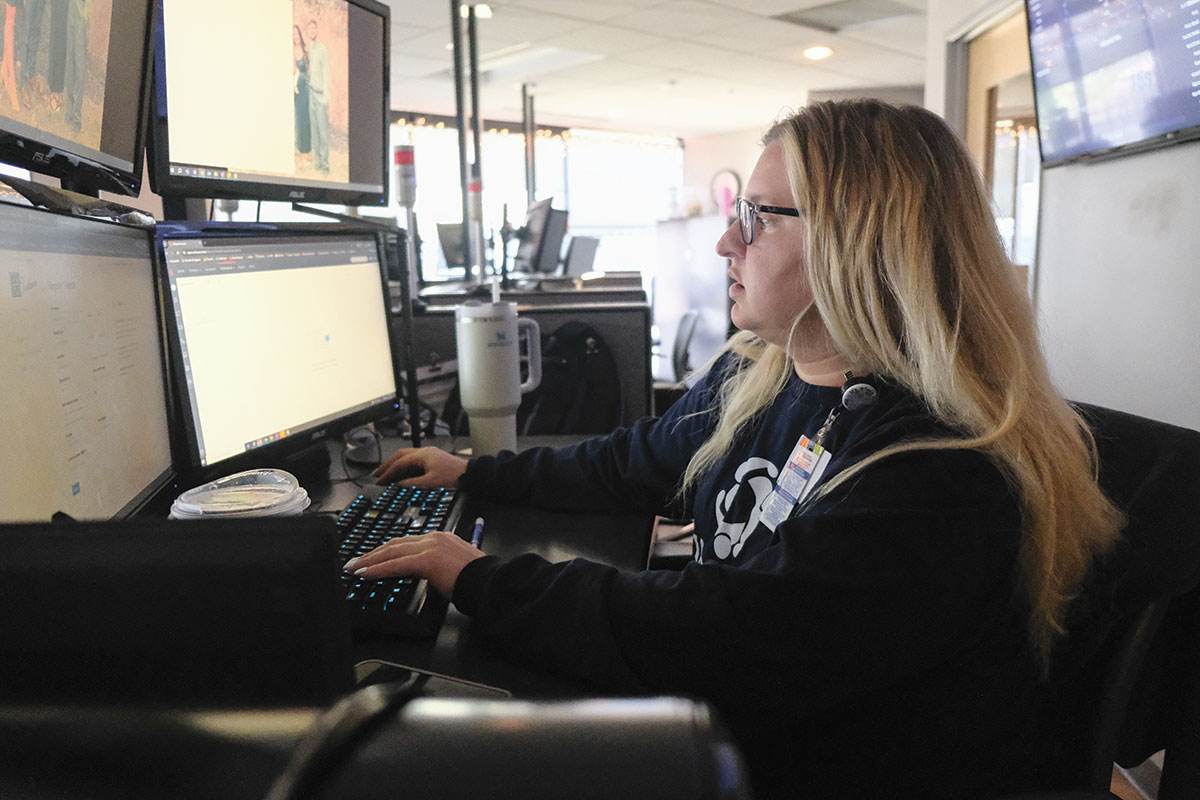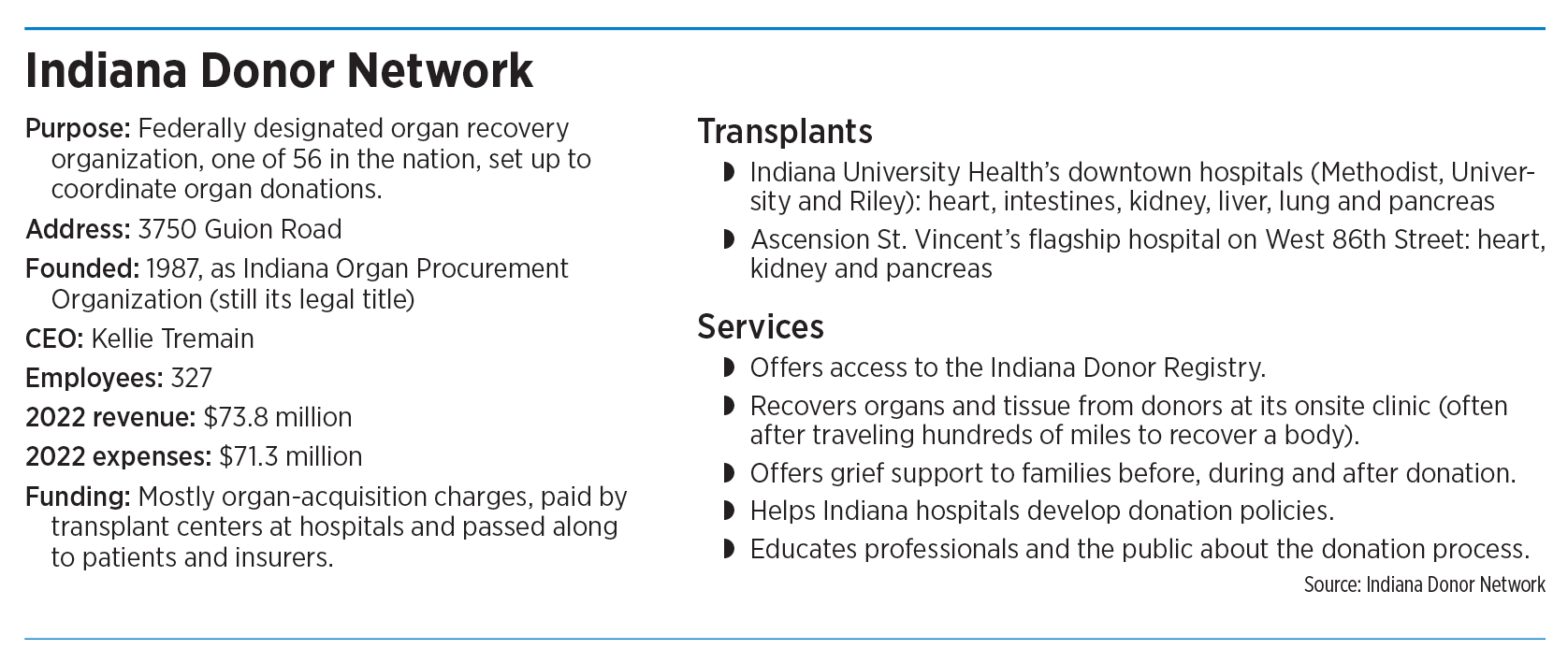Subscriber Benefit
As a subscriber you can listen to articles at work, in the car, or while you work out. Subscribe NowJamie Jessen put on her headset and pressed a button at her workstation. On the line was a hospital in Fort Wayne. An elderly woman in the hospital’s intensive care unit was failing, the hospital said, and might be available to offer a tissue donation within hours.
“Is she on a ventilator?” Jessen, a clinic support coordinator with the Indiana Donor Network, asked the hospital coordinator.
“No.”
“Does she currently have a heartbeat?”
“Yes.”
“Any history of cancer or dementia?”
“No.”
After getting more details, Jessen made a note to alert the network it might need to dispatch a team to the hospital once the patient has died to transport her to Indianapolis for tissue recovery.
The Indianapolis-based network, one of 56 federally designated organ recovery organizations in the nation, typically handles more than 500 calls a week from hospitals around the state, alerting it that an organ or tissue is available, or soon could be.
And the organization, which serves 85 of Indiana’s 92 counties, is booming with a record number of registered donors and transplanted organs. Last year, it provided 1,134 organ donations to hospitals, mostly in the Midwest, for transplanting into patients. That marked a new high in the organization’s 37-year history, up 17% from the previous year.

Last year, the network signed up more than 925,000 Indiana residents to become organ and tissue donors, bringing the total to 4.4 million potential donors.
“Our end goal is always to end the wait for life-saving organ transplants,” CEO Kellie Tremain said. “So we’re just trying to take every step possible in that direction.”
But the not-for-profit created in 1987 now faces big potential changes, along with the rest of the national network.
In September, President Joe Biden signed into law a bill designed to overhaul the country’s organ transplant system by increasing competition among contractors and paving the way for additional funding.
The new law will “break up the current monopoly system” that for nearly four decades allowed a single private not-for-profit to be the sole contractor managing the country’s Organ Procurement and Transplantation Network, White House Press Secretary Karine Jean-Pierre told reporters last fall.
She added that the law will allow the federal government to contract with outside vendors to provide “a more efficient system for the people it serves.”
The bill had bipartisan support as it advanced through Congress. Sens. Todd Young, R-Indiana, Chuck Grassley, R-Iowa, Ron Wyden, D-Oregon, Ben Cardin, D-Maryland, and Bill Cassidy, R-Louisiana, were among those pushing the Senate’s version of the bill. Reps. Larry Bucshon, R-Indiana, and Robin Kelly, D-Illinois, introduced the House’s version.
“This is a banner day in the effort to improve the organ transplant system in the United States,” Wyden, chair of the Senate Finance Committee and one of the act’s sponsors, said in a statement last fall. “For too long, thousands of families have had to watch a loved one struggle while waiting for an organ transplant because the system has been inefficient and unaccountable. With this law, that starts to change: There is going to be accountability, know-how and improvements … so more Americans are connected with a life-saving transplant.”
The Indiana Donor Network said it is “prepared to work with any national partner” to place organs for patients in need.
Saving more lives
The White House said the move is intended to shorten wait times and reduce the number of patients who die while waiting.
Across the United States, more than 103,000 people are on the national transplant waiting list, and each day, 17 people die waiting for an organ transplant, according to the U.S. Health Resources & Services Administration.
The United Network for Organ Sharing, the national not-for-profit that has been managing the network and coordinating transplants, has said it welcomes plans to reform the national system and supports “a more competitive and open bidding process.”
For its part, the Indiana Donor Network is beefing up its ranks to increase the number of donors and shorten the waiting time for transplants.
Last year, the network hired 107 employees, for a total of 327—its largest staff ever.
Employees led more than 1,000 school and community presentations. They also provided grief and counseling services to nearly 3,000 family members of organ and tissue donors. And they created a department specifically to educate hospitals about donation and transplantation.
“I would say we’ve pretty much grown every single department over the last couple of years,” Tremain said.
Organ transplants are big business. A hospital bill for a liver transplant can cost more than $800,000, and a heart transplant can cost $1.6 million, according to a 2020 report by Seattle-based Milliman Research. Costs for multiple-organ transplants can reach $2.6 million. That includes organ procurement, physician services, drugs, lab tests, 30 days of pre-transplant medical costs and 180 days of follow-up care.

Indiana transplants
In Indiana, only two hospital systems perform transplant services: Indiana University Health’s downtown hospitals (Methodist, University and Riley), which did 515 transplants last year; and Ascension St. Vincent’s flagship on West 86th Street, which did 101.
Lutheran Hospital in Fort Wayne last year announced it was shutting down its transplant services, citing low volumes.

Perhaps more than any other hospital service, an organ transplant program depends on high volumes and market share to offset huge fixed costs.
So hospitals doing transplants generally don’t see a short-term payoff, said Ed Abel, retired director of health care practice at Indianapolis-based Blue & Co., an accounting and consulting firm.
“They’re doing it because, when you provide those services, you elevate your health system to a new level,” he said. “It takes significant teams of clinicians who are highly trained. Once you have established a reputation for organ transplants, people want to bring you other things because they know you’re good at something that’s very complex.”
Indiana University Health ranked fourth in the nation last year in volume for transplanting pancreases (32) and intestines (nine), and ninth for livers (189).

It ranked lower for kidneys, hearts and lungs, perhaps due to the high number of transplants of those organs around the country. Leading hospitals, including Mayo Clinic and the University of California San Francisco Medical Center, did more than 400 kidney transplants last year, compared with 205 at IU Health, according to the Organ Procurement and Transplantation Network.
The Indianapolis-based hospital system said demand for transplants is high, but one factor limiting growth is the shortage of personnel, including highly trained transplant nurses.
“It’s very labor-intensive to do the number of transplants that we do,” said Dr. Jonathan Fridell, IU Health’s chief of abdominal transplant. “And we’ve rolled with the punches, and things have gone well, but it requires a very dedicated team of nurses in order to make this work. … We’re perpetually looking.”
Making matches
The Indiana Donor Network’s beefed-up staff of more than 300 is up from about 100 a decade ago. That includes a team of jet pilots and road drivers who scramble to get nurses and technicians to hospitals around the state to examine and transport donors back to Indianapolis.
Only about 15% of the organs that Indiana Donor Network recovers remain in Indiana for transplanting; the rest are sent to transplant centers and hospitals in other states. “The goal is to get the organ to the sickest patient within about a 500-mile radius,” Tremain said.
Under a complex formula that combines donor and candidate information, a national computer matches organs for transplanting. But the process can be painstaking. Traditional organ donation requires a person to be in a hospital and on a ventilator when pronounced dead. If a person experiences cardiac death, which means the heart has stopped and will not work again, the organs have usually started to break down from lack of blood flow and will likely not be removed and reused.
The manner in which a person dies often does not allow them to be an organ donor, such as dying of trauma, in a workplace accident or other circumstances where immediate death occurs.
“The medical condition of a potential donor at time of death determines if donation is possible and what organs and tissue can be donated,” according to the Indiana Donor Network website. “Only three of every 1,000 people are medically eligible to become organ donors.”
Facility upgrades
The network is spending millions of dollars to update and expand its facilities on Guion Road, just off of Interstate 65 at West 38th Street.
For years, all offices were inside one low-slung building on the property. A few years ago, the Indiana Donor Network bought a nearby, four-story building for $2.2 million from the AAA Hoosier Motor Club, which was relocating. The donor network spent nearly $16 million to renovate and modernize the building as its administrative offices and space for community events and education, with new elevators, staircases, offices and meeting rooms.
In 2020, it updated its original building, just a few dozen steps from its new headquarters, as its Organ and Tissue Recovery Center. The network said the cost of buying and installing medical and diagnostic equipment was $3.3 million, and the network estimates additional renovations will cost another $2.5 million when the update is finished next year.
A walk through the Organ and Tissue Recovery Center is like a visit to a small hospital. It contains a CT scanner and other imaging equipment for examining donated organs, along with a sterilization area.
It also contains a five-bed intensive-care unit, where brain-dead patients on ventilators are held before they are moved to one of two large operating rooms, where surgeons can recover organs and tissue.

“This is an organ recovery suite,” Steve Johnson, the network’s chief operating officer, said as he led an IBJ reporter and photographer into a large surgical area. “The only difference between this and a normal O.R. is, it’s bigger. You have a team for the lungs, a team for the liver, a team for kidneys. So you have a surgeon with their team for each individual organ. You’ve got a lot of people in this room that have to work in unison.”
On this particular day, no donors are in the clinic. The organ-recovery suite and the ICU are unoccupied.
In another room, 12 kidney perfusion pumps keep blood circulating through the harvested kidneys, allowing doctors to continually monitor the condition of the organs.
Nearby, a new machine called a LifePort Liver Transporter was used for the first time last year under a study authorized by the U.S. Food and Drug Administration. The liver was donated by a 90-year-old Indiana woman and was transplanted into a patient in Cincinnati.
With the new technology, larger staff and modernized facilities, the Indiana Donor Network sounds optimistic it can continue its eight-year streak of increasing donations and transplants. In about a decade, it has more than doubled the number of organs it has sent to hospitals for transplanting.
“The growth is incredible,” Johnson said. “And it’s because Indiana has grown that much. It’s because we’re getting the word out, embracing the community, and creating good relationships and trust within the community as well as our health care providers.”•
Please enable JavaScript to view this content.



Very interesting just how all this is accomplished…being an organ donor, myself.